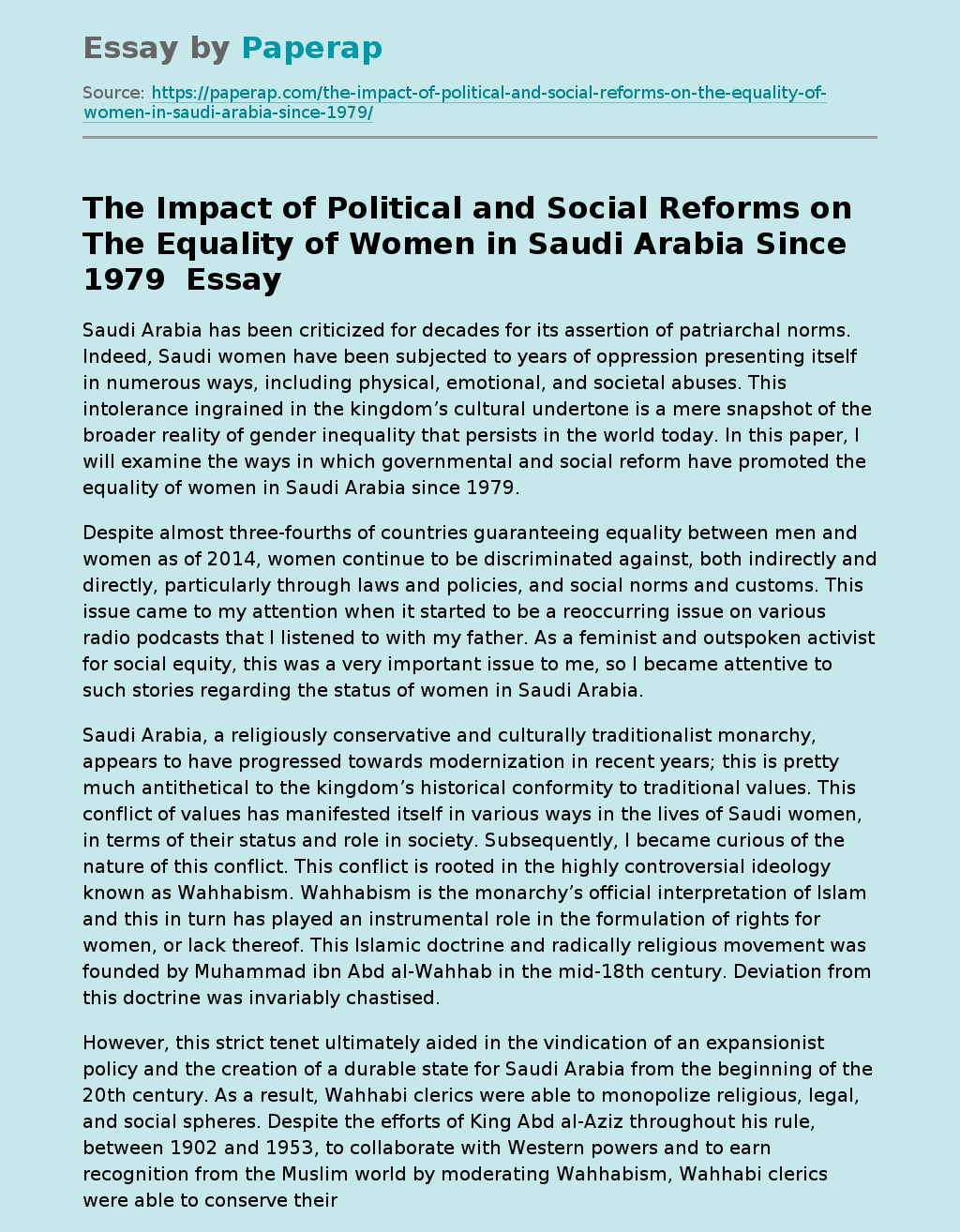Reforms & Women's Equality in Saudi Arabia
Saudi Arabia has been criticized for decades for its assertion of patriarchal norms. Indeed, Saudi women have been subjected to years of oppression presenting itself in numerous ways, including physical, emotional, and societal abuses. This intolerance ingrained in the kingdom’s cultural undertone is a mere snapshot of the broader reality of gender inequality that persists in the world today. In this paper, I will examine the ways in which governmental and social reform have promoted the equality of women in Saudi Arabia since 1979.
Despite almost three-fourths of countries guaranteeing equality between men and women as of 2014, women continue to be discriminated against, both indirectly and directly, particularly through laws and policies, and social norms and customs. This issue came to my attention when it started to be a reoccurring issue on various radio podcasts that I listened to with my father. As a feminist and outspoken activist for social equity, this was a very important issue to me, so I became attentive to such stories regarding the status of women in Saudi Arabia.
Saudi Arabia, a religiously conservative and culturally traditionalist monarchy, appears to have progressed towards modernization in recent years; this is pretty much antithetical to the kingdom’s historical conformity to traditional values. This conflict of values has manifested itself in various ways in the lives of Saudi women, in terms of their status and role in society. Subsequently, I became curious of the nature of this conflict. This conflict is rooted in the highly controversial ideology known as Wahhabism.
Wahhabism is the monarchy’s official interpretation of Islam and this in turn has played an instrumental role in the formulation of rights for women, or lack thereof. This Islamic doctrine and radically religious movement was founded by Muhammad ibn Abd al-Wahhab in the mid-18th century. Deviation from this doctrine was invariably chastised.
However, this strict tenet ultimately aided in the vindication of an expansionist policy and the creation of a durable state for Saudi Arabia from the beginning of the 20th century. As a result, Wahhabi clerics were able to monopolize religious, legal, and social spheres. Despite the efforts of King Abd al-Aziz throughout his rule, between 1902 and 1953, to collaborate with Western powers and to earn recognition from the Muslim world by moderating Wahhabism, Wahhabi clerics were able to conserve their authority. Thereafter, several historical events, most notably the Islamic revolution in Iran, the seizure of the Grand Mosque in Mecca and the Soviet invasion of Afghanistan in 1979, led to a surge in compliance with the foundations of Wahhabism. As a result, the Saudi monarchy narrowed its public manifestation of sharia law in order to restore its credibility.
Forty years later, the current Saudi Crown Prince, Mohammed bin Salman, has advocated political and social reforms towards re-establishing “the real Saudi Arabia”, as he stated in a recent interview with CBS News’ 60 Minutes. He distinguishes the “strict, harsh and intolerant” disposition of present-day Islam in the kingdom as incongruous with its disposition prior to 1979. Moreover, the Crown Prince asserts that modern-day Saudi Arabia is now “in the midst of own cultural revolution”.
Historically, Saudi Arabia has manifestly displayed tendencies of the discrimination of women through its political, cultural, and social norms. On account of this discrimination, there have been multifarious reforms to promote the equality of women in the kingdom, particularly since the constricting of Saudi values after 1979. The extent to which these reforms were either supported or hindered by changes in governmental regulation or by shifts in social and cultural attitudes is thus subject to debate. This essay attempts to analyze these reforms and evaluate their consequences on the lives of Saudi women by examining two Saudi social norms — the male guardianship system and gender segregation – via the subject lenses of Social and Cultural Anthropology and Global Politics.
For the purposes of this essay, equality is defined as both women and men having the same intrinsic value in society. Additionally, as a result of the growing polarization of societies, which will be demonstrated throughout this essay, equality is closely linked to justice and liberty, as different people have different access to different opportunities. Meanwhile, the term ‘norm’ is defined as a standard of judgment by which a social attitude or behavior is accepted. An interdisciplinary approach to my research question allows for the juxtaposition of the inequality of women in Saudi Arabia, a global political challenge that is characterized by rapid change and increasing interconnectedness, and how this issue confronts the cultural assumptions established by the distinctive socio-political balance of power exhibited within the kingdom.
Reforms & Women's Equality in Saudi Arabia. (2021, Dec 10). Retrieved from https://paperap.com/the-impact-of-political-and-social-reforms-on-the-equality-of-women-in-saudi-arabia-since-1979/

